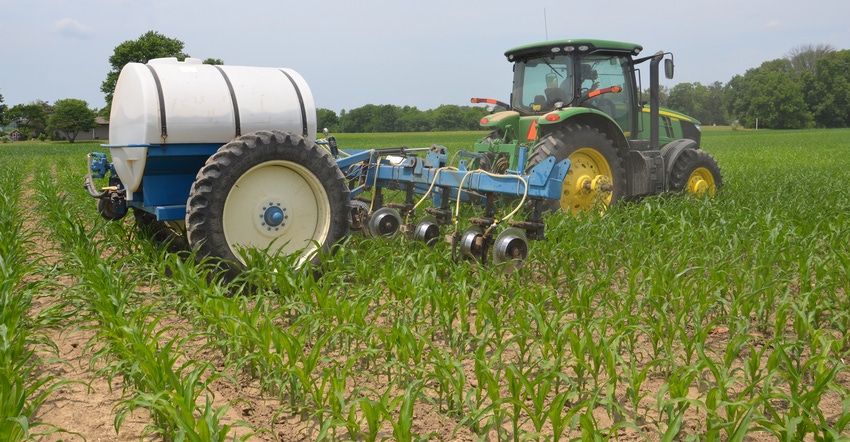
Nitrogen for the Corn Watch ’20 field was applied about a month before planting. The operator applied anhydrous ammonia. The field was planted May 13.
“This is a key time to make sure you have enough nitrogen applied for the crop,” says Dave Nanda, director of genetics for Seed Genetics Direct, sponsor of Corn Watch ’20.
“Except for a few wet spots, the stand in most of the Corn Watch ’20 field is good, averaging around 30,000 plants per acre,” Nanda continues. “When you have a good stand, you want to make sure you have enough nitrogen applied so that it can reach its potential.”
Here are several variables to consider. Some you can control, and others are out of your control:
Where you farm. Bob Nielsen and Jim Camberato, Purdue University agronomists and Extension specialists, conducted nitrogen on-farm and large-plot field trials for over a decade in Indiana to arrive at recommended nitrogen rates. Economic optimum rates vary from 170 to 210 pounds per acre, depending upon soil types and location. Agronomic maximum rates to reach top yields vary from 210 to 263 pounds per acre.
While their data is specific to Indiana, performance likely varies with soil types and conditions elsewhere too. The Iowa State University Corn Nitrogen Rate Calculator includes data from several different states.
Mineralization rate. The soil will supply some nitrogen, based on amount of organic matter and how quickly nutrients are released during the season. Work by specialists indicates that this can vary significantly based on environmental factors, including temperature and rainfall. Agronomists believe it’s one reason why you may produce a bushel of corn on just 0.7 pound of nitrogen per bushel some years and require 1.2 to 1.3 pounds of nitrogen per bushel in other years.
Sidedressing nitrogen. If you apply some nitrogen by sidedressing, perhaps you’ve already applied it this year. If not, you may need to apply it soon before corn is too tall, Nanda says. It’s one drawback to depending on sidedressing. However, if you can’t get nitrogen applied on time due to weather, high-clearance rigs are common at dealerships, and let you apply in taller corn. It may mean shifting form of nitrogen.
Planned late-season applications. More people are choosing to apply a portion of the total nitrogen they intend to use with high-clearance rigs and Y-drops at the V10 stage or later. The theory is to provide a portion of the nitrogen closer to the time most hybrids use a large chunk of nitrogen, Camberato says. However, testing by Nielsen and Camberato on whether a planned late-season application pays is inconsistent. Some years it paid at some locations, and in other years it didn’t pay.
Nitrogen testing. If you suspect you’ve lost some nitrogen applied early due to denitrification or volatilization, test plants to see how much nitrogen they contain. Traditional tissue testing is one method, says Betsy Bower, Ceres Solutions, Terre Haute, Ind. She helps several customers conduct routine tissue testing to check for nitrogen and other nutrients.
You can also check with a chlorophyll meter, if a crops consultant has one available. It’s an expensive tool. A regular soil test is ineffective for nitrogen. A deep soil test developed by ISU can be used to check nitrogen content. However, most consultants report that it’s most effective where manure has been applied or in high organic-matter situations.
About the Author(s)
You May Also Like




